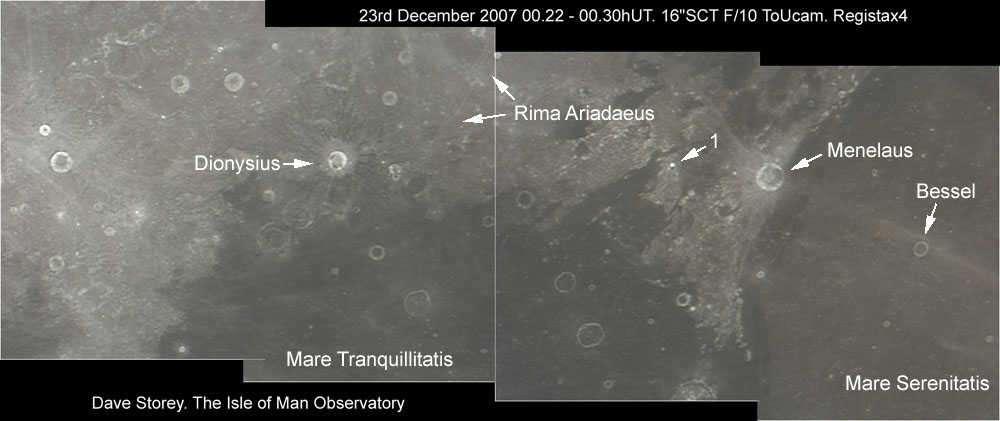Difference between revisions of "March 12, 2008"
| (3 intermediate revisions by the same user not shown) | |||
| Line 1: | Line 1: | ||
__NOTOC__ | __NOTOC__ | ||
| − | =Crater Rings, Spots | + | =Crater Rings, Spots and Rays During Full Moon= |
<!-- Start of content --> | <!-- Start of content --> | ||
<!-- ws:start:WikiTextHeadingRule:0:<h1> --> | <!-- ws:start:WikiTextHeadingRule:0:<h1> --> | ||
| − | [ | + | [https://the-moon.us/wiki/space/showimage/LPOD-Mar12-08.jpg [[File:LPOD-Mar12-08_labeled.jpg]]]<!-- ws:end:WikiTextLocalImageRule:5 --><br /> |
<em>image by [mailto:dave.storey@iomastronomy.org Dave Storey]</em> (click on it for the full-sized version, without labels) <em>North is to the right</em><br /> | <em>image by [mailto:dave.storey@iomastronomy.org Dave Storey]</em> (click on it for the full-sized version, without labels) <em>North is to the right</em><br /> | ||
<br /> | <br /> | ||
| − | I quite often tell novice astronomers that the best time to observe details upon the lunar surface is during crescent to half phase of the [http://en.wikipedia.org/wiki/Lunar_phase lunar cycle], when shadow relief is brought out along the terminator. This is good advice but there are lots of delicate details to be gleaned when the phase is near Full Moon. First, this image is in colour and there is definite [ | + | I quite often tell novice astronomers that the best time to observe details upon the lunar surface is during crescent to half phase of the [http://en.wikipedia.org/wiki/Lunar_phase lunar cycle], when shadow relief is brought out along the terminator. This is good advice but there are lots of delicate details to be gleaned when the phase is near Full Moon. First, this image is in colour and there is definite [[May_4,_2007|Mare Serenitatis]].<br /> |
<br /> | <br /> | ||
<em>Dave Storey</em><br /> | <em>Dave Storey</em><br /> | ||
| Line 16: | Line 16: | ||
Rükl plates 44,45,34,35,23 & 24.<br /> | Rükl plates 44,45,34,35,23 & 24.<br /> | ||
Dave's website: [http://blog.iomastronomy.org/ IomStargazer] Dave's Local Astronomical Society [http://www.iomastronomy.org/ IoMAS]<br /> | Dave's website: [http://blog.iomastronomy.org/ IomStargazer] Dave's Local Astronomical Society [http://www.iomastronomy.org/ IoMAS]<br /> | ||
| − | LPOD: [ | + | LPOD: [[April_17,_2006|Anti-Sun Moon]]<br /> |
<br /> | <br /> | ||
<p><b>Yesterday's LPOD:</b> [[March 11, 2008|Lunar Pathfinder Getting Ready]] </p> | <p><b>Yesterday's LPOD:</b> [[March 11, 2008|Lunar Pathfinder Getting Ready]] </p> | ||
Latest revision as of 19:27, 18 August 2018
Crater Rings, Spots and Rays During Full Moon

image by Dave Storey (click on it for the full-sized version, without labels) North is to the right
I quite often tell novice astronomers that the best time to observe details upon the lunar surface is during crescent to half phase of the lunar cycle, when shadow relief is brought out along the terminator. This is good advice but there are lots of delicate details to be gleaned when the phase is near Full Moon. First, this image is in colour and there is definite Mare Serenitatis.
Dave Storey
Technical Details
16" Meade SCT at F/10. Imaged by Phillips ToUcam 740K. Processed Registax 4.
Related Links
Rükl plates 44,45,34,35,23 & 24.
Dave's website: IomStargazer Dave's Local Astronomical Society IoMAS
LPOD: Anti-Sun Moon
Yesterday's LPOD: Lunar Pathfinder Getting Ready
Tomorrow's LPOD: The Great Migration
COMMENTS
1) Thanks, Dave! Today I talked with the person who plans where the Kaguya HDTV obtains data. They will be entering a period soon where the flight path it is away from the terminator. I encouraged him to continue imaging because there are many fascinating things to see at higher Sun, just as you show today.
Chuck
COMMENTS?
Register, Log in, and join in the comments.



